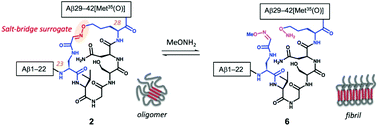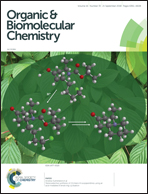A chemically engineered, stable oligomer mimic of amyloid β42 containing an oxime switch for fibril formation†
Abstract
Toxic aggregation of monomeric amyloid β (Aβ) into oligomers followed by the formation of fibrils is a causative process in the pathogenesis of Alzheimer's disease. The mechanism for furnishing the toxicity of Aβ aggregates is elusive, however, mainly due to the transient, unstable properties of the oligomer states. Oligomer mimics stabilized by chemical protein engineering are potentially useful tools for elucidating the pathogenicity of Aβ aggregates. Here we report a stable Aβ oligomer mimic that is transformed into fibrils by a chemical stimulus, i.e., an oxime exchange reaction. A derivative of Aβ42[Met35(O)], compound 2, containing an oxime tether between residues 23 and 28 (a salt-bridge surrogate between Asp23 and Lys28 of the Aβ42 oligomer), rapidly and homogeneously formed stable, relatively large oligomers with preserved amyloid-like properties, such as the propensity to form β-sheets and toxicity. Chemical cleavage of the tether via an oxime exchange reaction induced transformation of the oligomers into the fibril state. These results demonstrate that the oxime bond formation/cleavage can switch the aggregation state of the mimic by functionally surrogating the salt-bridge of Aβ42. This novel system temporally dissects the dynamic process of Aβ aggregation, and thus might offer a unique molecular tool for exploring the properties of Aβ oligomers and fibrils.

- This article is part of the themed collection: Chemical Biology in OBC


 Please wait while we load your content...
Please wait while we load your content...